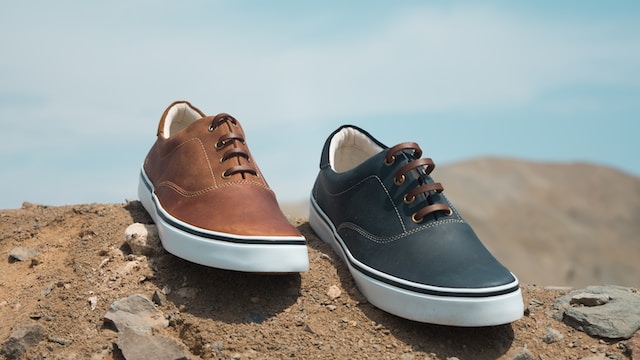
In the ever-changing landscape of style and fashion, one element that has remained constant is the evolution of footwear. Throughout fashion history, footwear has evolved from simple necessities to symbols of identity and style. From the practicality of early sandals to the intricate designs of modern-day sneakers, the progression of footwear reflects the growth of human civilization.
Footwear has always served a basic purpose: to protect our feet from harsh terrains, extreme temperatures, and potential injury. Early civilizations fashioned shoes from whatever materials were readily available – animal hides, leaves, and even tree bark. These rudimentary shoes were functional, providing minimal protection and support.
Ancient Civilizations and Sandals
The evolution of footwear can be traced back to the ancient civilizations that roamed the Earth. Among them, the Egyptians, Greeks, and Romans were pioneers in shaping the early foundations of footwear design.
In ancient Egypt, the scorching desert sands necessitated the creation of sandals that provided protection from the blistering heat. Crafted from simple materials like papyrus and palm leaves, these sandals were a rudimentary yet essential part of daily life. As time passed, the Egyptians began using sturdier materials like leather, signalling the next step in the evolution of footwear.
The Greeks, known for their penchant for artistry and beauty, took great pride in their footwear. The ancient Greeks elevated the concept of sandals beyond mere functionality, transforming them into elaborate symbols of status and style. These sandals were often embellished with intricate designs and made from equally luxurious materials such as silk and gold. From simple straps to more complex lace-up designs, the Greeks proved that footwear could be much more than a basic necessity.
The Romans, with their far-reaching empire and military prowess, further refined the art of shoemaking. Not content with simple sandals, the Romans introduced the concept of sturdy leather boots for their soldiers. These boots provided protection and support, allowing their troops to march confidently on various terrains. As the Roman Empire expanded, so too did their influence on footwear design, with their Roman-style sandals becoming popular across different regions.
Medieval and Renaissance Footwear
In the early Middle Ages, footwear became more utilitarian and practical. Peasants and commoners wore simple shoes made from leather or fabric, stitched together with basic techniques. These shoes offered minimal protection but were essential for daily survival.
However, the evolution of footwear did not solely cater to functionality. With the rise of nobility and social hierarchy, footwear began to serve as a display of wealth and status. The higher classes embraced the concept of ostentatious footwear, showcasing their privilege through elaborate designs. Intricate embroidery, jewels, and rich fabrics adorned the shoes of the aristocracy, making a bold statement about their position in society.

The Renaissance Period
The Renaissance period, which followed the Middle Ages, brought about a renewed interest in the arts, sciences, and human potential. Footwear, too, experienced a transformation during this time. The focus shifted towards achieving balance between style and comfort.
The Italians, known for their sense of fashion and craftsmanship, led the way in this new era of footwear. They introduced innovations such as the heel and the platform sole. These additions not only enhanced the aesthetics of the shoes but also provided individuals with a more comfortable walking experience.
Fashion and Footwear
Fashion also played a vital role in the evolution of Renaissance footwear. Women’s shoes became increasingly delicate and decorative, emphasizing beauty and femininity. The famous chopine shoes, with their towering platform soles, signified wealth and prestige. However, these shoes were not practical for everyday wear and were often reserved for special occasions.
Footwear for men underwent changes as well. The introduction of loafers, a slip-on style of shoe, provided a more convenient and relaxed option. These shoes emphasized functionality and ease of movement, a departure from the previously ornate and restrictive designs.
The Age of Enlightenment
The Age of Enlightenment marked a significant period in the evolution of footwear, as society began to prioritize rationality and scientific progress. This shift in mindset had a direct influence on fashion, including footwear. Practicality and function became paramount during this era, and simplicity reigned supreme. Shoes were designed with comfort and durability in mind, reflecting the growing belief in practicality over extravagance.
The Enlightenment era also saw the rise of industrialization, which revolutionized the production of footwear. Mass production techniques allowed shoes to be produced more efficiently and at a lower cost, making them more accessible to the general population. As the Industrial Revolution took hold, advancements in technology and manufacturing techniques led to the introduction of new materials such as rubber and vulcanized rubber.
The Introduction of Heels
The Victorian-era fashion introduced the concept of the delicate and narrow heel, which added a touch of elegance to women’s footwear. However, comfort took a backseat during this time, with narrow and tight-fitting shoes being the norm. Women frequently endured discomfort and even physical pain in pursuit of fashionable footwear.
Men’s footwear during the Victorian era reflected a more practical approach, with sturdy boots being the preferred choice for everyday wear. The Industrial Revolution, with its advancements in machinery, allowed for the mass production of boots, making them more affordable and accessible to a wider range of individuals. The Victorian era also saw the emergence of the oxford shoe, a versatile and timeless design that remains popular to this day.
The 21st Century: The Sneaker Revolution and Beyond

In the fast-paced world of the 21st century, the evolution of footwear has reached new heights with the emergence of the sneaker revolution. Sneakers, once reserved for athletic endeavors, have now become a symbol of urban and street style and self-expression. With their comfortable fit and versatile designs, sneakers have infiltrated every aspect of our lives, from casual outings to high-fashion runways. The concept of footwear has expanded beyond practicality and has become a statement of identity and individuality.
The sneaker revolution is marked by the fusion of innovation, technology, and creativity. Brands strive to push the boundaries of design and functionality, with each new release surpassing the previous in terms of style and performance. Sneakers are no longer mere accessories. They have become coveted collector’s items and status symbols.
Advanced Materials in Footwear
The evolution of footwear in the 21st century is driven by our ever-changing lifestyles and the need for adaptability. Sneakers are now crafted with advanced materials, such as breathable mesh, lightweight foams, and high-tech cushioning systems, ensuring maximum comfort and support. Whether you’re hitting the gym or strolling through the city streets, sneakers are designed to keep up with your dynamic lifestyle.
Furthermore, the sneaker revolution has brought together diverse communities, bridging gaps between fashion enthusiasts, athletes, and sneakerheads. Sneaker culture has become a global phenomenon, with sneakerheads eagerly awaiting the release of limited-edition collaborations and exclusive colorways. These shoes have created a sense of community, with enthusiasts coming together to share their passion for footwear and engage in spirited discussions about design and style.
As we move further into the 21st century, the evolution of footwear shows no signs of slowing down. In a world where trends come and go, our desire for unique and expressive footwear remains unwavering. The evolution of footwear tells the story of human ingenuity and our quest for both practicality and self-expression. From simple sandals crafted centuries ago to the cutting-edge sneakers of today, the evolution of footwear continues to shape our personal style and the way we navigate the world.
